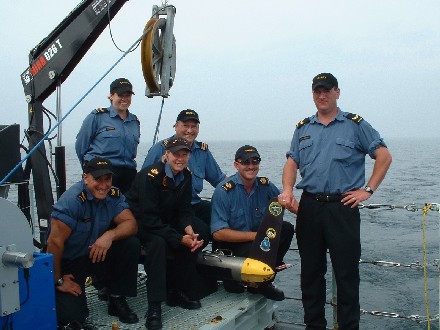|
Domestic Operations TRINITY's "Fiona" takes the plunge in search of Avro ArrowBy Naomi Belleau
HMCS KINGSTON — “Like trying to find a needle in a haystack”, was the key message during the Navy’s July 5-7 expedition in search of the elusive Avro Arrow scale models believed to be on the bottom of Lake Ontario.

Credit: Naomi Belleau
Crewmembers from TRINITY Route Survey Office pose aboard HMCS KINGSTON |
Using “Fiona”, their Klein 5 500 high-definition side-scan sonar, crewmembers from TRINITY Route Survey Office aboard HMCS KINGSTON searched an area a few kilometres off Point Petre, Ont., for eight miniature test versions of the Avro Arrow.
The baby Arrows measured only three-metres long by two-metres wide and were thought to be located somewhere within a search area equivalent to roughly 40 km2.
“One of the most difficult parts of this job is figuring out what the objects on the seabed are,” explains Master Seaman Daisy Lacroix, from TRINITY, while looking for tiny Avro Arrow shaped irregularities on the digital output of the side-scan sonar.
Each “object of interest” identified by TRINITY was reported to the Fleet Diving Unit (Atlantic) on HMCS GLACE BAY. FDU(A) then sent down their phantom remotely operated vehicle (ROV), whose powerful video cameras relayed crystal-clear images back to the ship.
Although many of the targets on the seabed ended up being large rocks, the Navy did not come away empty-handed. Four rocket boosters and a schooner thought to be from the mid-1800s, were the highlights of a three-day search for the Arrow models.

Credit: Canadian Navy
Side-scan sonar image of Schooner thought to be from the mid-1800's. |
At least one of the rocket boosters was confirmed to be a Nike booster, the exact same type fired from Point Petre Range from 1954-57 with an Arrow model in piggyback. Despite a flight time of mere seconds, the Avro Arrow models likely reached speeds of Mach 2.6 or roughly 3 000 km/h before disappearing beneath the surface of Lake Ontario.
In addition to discovering the rocket boosters, TRINITY was also able to map some of Lake Ontario’s seabed.
“Our ultimate goal would be to map all Canadian owned waters,” explains Petty Officer, 2nd Class Ronald Clark, senior analyst at TRINITY, “but realistically we would like to get the main routes done then fill in the rest.”
On the East Coast, TRINITY has already done extensive mapping of Halifax Harbour and the St-Lawrence Seaway to be used in mine countermeasures. The work that they do is essential to ensuring the security of the commercial sea routes.
“Since September 11, the importance of this job has been brought to the forefront,” affirms Lieutenant(N) Scott Moody, route survey operations officer at TRINITY. “The United States transports roughly 90 percent of their goods by sea.”
The team also uses their side-scan sonar to detect unexploded ordnance that may be left over from the war and to participate in search efforts such as the Snowbird crash on Lake Erie and the Swiss Air crash off Peggy’s Cove in Nova Scotia. However, one of the challenges that TRINITY faces is logging sea time.
“The side-scan sonar just isn’t something you can practice in the office,” explains Lt(N) Moody who also said he was eager to participate with the FDU(A) and HMC Ships GLACE BAY and KINGSTON in the search for the Avro Arrow models.
The Arrow model search took place while both ships were on a training cruise in the Great Lakes to provide watchkeeping and navigation training to Reservists. When the request for assistance in locating the Arrow models was received from the Aerospace Heritage Foundation of Canada, the Navy concluded that approximately 36 hours over a three-day period could be used for this. It was determined that the search would further enhance training for all.
Ms. Belleau is with Navy PA.
Back to Listing
|
